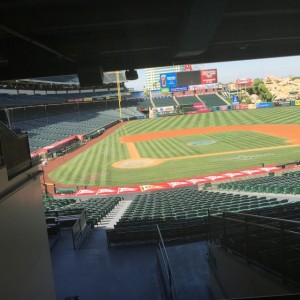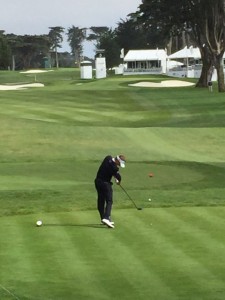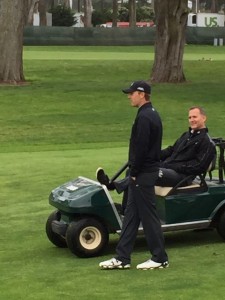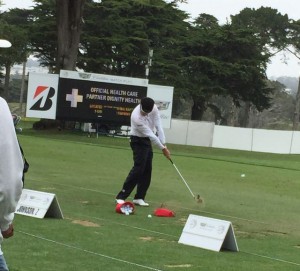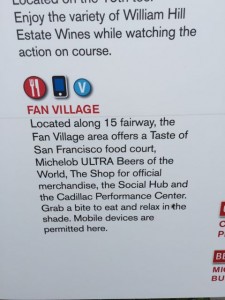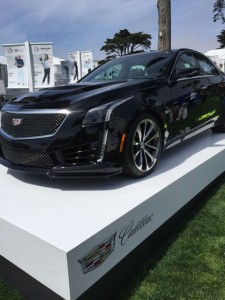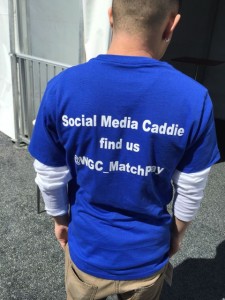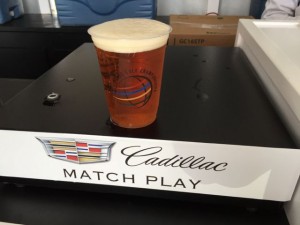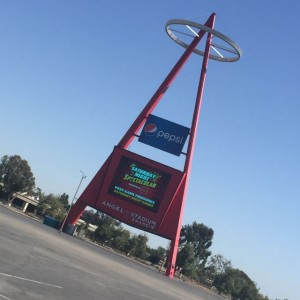
The iconic sign outside the “Big A,” aka Angels Stadium of Anaheim. Credit all photos, even tilted ones: Terry Sweeney, MSR (click on any photo for a larger image)
“Fans expect connectivity these days,” Castro told Mobile Sports Report during a tour of Angels Stadium, aka the Big A, which was built in 1966. Once the home of the NFL’s Los Angeles Rams, the stadium went through and extensive renovation in 1997-98 and now seats about 44,000 for baseball and serves 3 million visitors annually. “If they’re going to come to a ballgame for four hours,” said Castro of today’s fans, “they won’t tolerate not being connected.”
Adding wireless to the ‘Big A’
To get the wireless ball rolling last year, teams of engineers on scaffolding started on the uppermost tier of the Big A (the “View Level”) to mount DAS and Wi-Fi antennas to the stadium canopy. Working from outermost edges of the C-shaped stadium, two sets at of scaffolding at each end leapfrogged each til they met in the middle – a five-week process, according to Castro.
The 15-zone DAS network went live in June 2014 with Verizon, AT&T and T-Mobile on board; Sprint is expected to add some antennas in the next several weeks. Currently, there are 122 DAS remotes in 33 locations. Angel Stadium Wi-Fi went live in September 2014 and now counts more than 400 access points around the stadium, according to team figures. Ruckus Wireless is the Wi-Fi vendor; the DAS gear is from Teko Telecom, now part of JMA Wireless.The Angels worked closely with technology partner 5 Bars, a builder of turnkey wireless networks for sports venues’ wireless needs. Castro would not disclose the budget for the wireless upgrades at Angels Stadium.
In addition to using Major League Baseball’s Ballpark app, Angels fans can post to social media, surf the Web and check email from the stadium’s wireless networks. On the stadium’s club level, spectators can wirelessly order food and beverage from their seats; Legends, which operates the stadium’s concessions, uses an unpublished SSID for 150 wireless-enabled moveable cash registers and more than two dozen handheld point-of-sale devices. Similarly, TicketMaster has its own invisible SSID for wireless scanning of tickets at the stadium’s entry gates; the SSID for the press box is also masked, according to Castro.
Hiding in plain (or painted) sight
The DAS antennas and APs have been strategically installed and well concealed; they’re as discrete as chameleons. Working with Ruckus gear, 5 Bars installed narrow-beam, sectorized-beam and high-capacity APs, all centrally managed by Ruckus’s SmartCell Gateway 200.
The Angels also use SmartCell Insight, a reporting and analytics package that helps the team track number of unique connections to the Wi-Fi during the course of a game, device types, total and average data uploaded and downloaded, and their speeds, Castro said.Angel Stadium Wi-Fi has been engineered for 20,000 simultaneous users; there’s no throttling of user bandwidth and no filtering for streaming media like Spotify — “yet,” Castro was quick to add with a laugh. Download speeds vary depending on crowd size, according to Tommy Taylor, senior manager, engineering services for 5 Bars. For a game with 36,000 in attendance, for example, average download speed for devices using 2.4 GHz bandwidth is 8-12 Mbps, while 5 GHz connections can run as fast as 18-24 Mbps. On the traffic side, currently the network is seeing upload volume of about 20 percent of the download average volume, Taylor said, in an email to Mobile Sports Report.
The Angels will continue to fine-tune the network and add or re-point APs as necessary. “We are in the process of adding additional APs to cover some areas that, when the stadium is full, do not receive the high level of coverage we are targeting to provide,” Castro said. Those additions should be done by mid-June. Management has an eye on monetizing the network through sponsorships, and extending the in-seat ordering system beyond the club level of the ballpark, according to Castro.
He also wants to add streaming video to the network so that fans can watch replay from multiple angles, which Castro described as “a good incentive — something you can’t get at home.” He also intends to expand his use of analytics and report generation on a game-by-game basis. It’s the sort of thing that the owners and managers of the team are increasingly interested in, Castro added.

